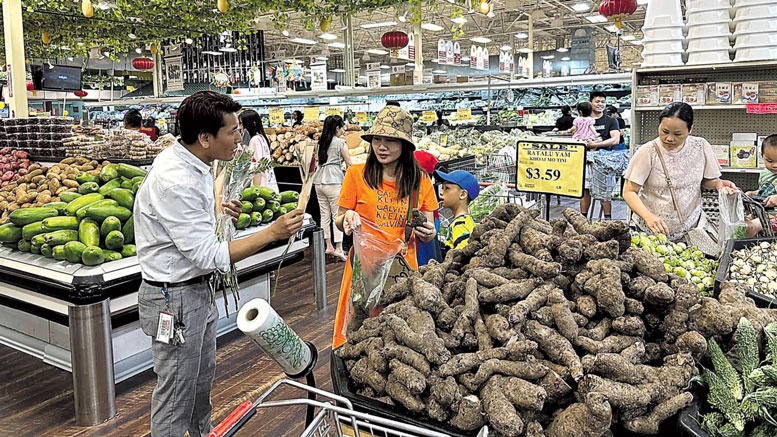Diversity Drives Produce Demand in Atlanta
October 15, 2024 | 7 min to read
Population growth in Atlanta has heightened the demand for fresh produce, attributed to its diverse cultural landscape and an expanding economy. As the metropolitan area approaches 7.9 million residents, consumers seek a variety of fruits and vegetables, reflecting both traditional Southern and international cuisines. The booming film industry and a rise in fine dining establishments further fuel this demand, while local partnerships ensure a consistent supply of high-quality ingredients essential for maintaining Atlanta's culinary reputation.

Population growth, sporting events and concerts drive increased demand for fresh produce.
Diversity drives demand for fresh fruits and vegetables in Atlanta, GA. This is especially true on two fronts.
First, there’s the ethnic makeup of urban-based Atlanta citizens and suburbanites living in the sprawling 28-county Atlanta Metropolitan Area. According to U.S. Census Bureau statistics for 2023, the area is now the sixth largest metropolitan region in the U.S., with a population of 6.3 million. Mexico, India, Jamaica, South Korea, Vietnam, China, Nigeria, Guatemala, El Salvador and Colombia were the top 10 countries Atlanta’s immigrants hailed from as of 2019, based on U.S. Census Bureau information.
“The Atlanta Metro market is unique in the U.S. due to its blend of a cosmopolitan nature and Southern roots. This fusion drives a high demand for a wide variety of fresh produce, catering to both traditional Southern tastes and international cuisines,” says Matthew Kulinski, director of marketing for the Georgia Department of Agriculture (GDA), in Atlanta.
“Over the years, the volume and variety of produce have expanded significantly. Atlanta’s growth as a multi-ethnic hub has increased demand for a range of fruits and vegetables, alongside staples like peaches and Vidalia onions.”
The Atlanta Regional Commission, a regional planning and intergovernmental agency, predicts the Atlanta Metro market’s population will hit 7.9 million and become even more diverse by 2050. Hispanics and Asian Americans are expected to represent more of the total population.
“Our customer base is mostly Hispanic, so we focus more on Hispanic, as well as Asian produce,” says Ricky Cho, general manager at City Farmers Market 2, Inc., a six-store chain in the Atlanta Metro market. “Roma tomatoes are one of our biggest items.”
Cho advertises 20 fruits and vegetables each week in the chain’s flyer. During the last week of July, these items included Mexican mangos, jicama, yuca, Thai guava, ong choy, red shen choy, bananas and black plums.
Second, there’s economic diversity. As of 2024, the Metro Atlanta area is the headquarters of 16 Fortune 500 companies, according to the Metro Atlanta Chamber, in Atlanta. The top five in descending order are The Home Depot, UPS, Delta Air Lines, The Coca-Cola Co. and the Southern Co.
“Atlanta’s booming economy and increasing affluence have led to higher spending power, enabling more people to dine out frequently and seek high-quality, fresh ingredients in their meals,” says Stephanie Fischer, president and chief executive officer of the Atlanta-based Georgia Restaurant Association (GRA).
“Atlanta’s booming economy and increasing affluence have led to higher spending power, enabling more people to dine out frequently and seek high-quality, fresh ingredients in their meals.”
— Stephanie Fischer, Georgia Restaurant Association, Atlanta, GA
More recently, the movie business has boomed in Atlanta, ignited by a 2008-implemented 20% to 30% tax credit for filmmakers. Several Marvel Studios films, Netflix’s Stranger Things, and Disney productions filmed here have given Atlanta the nickname “Hollywood of the South.”
“This influx of the movie business with its stars and studio staff has led to a growth in the number of fine dining restaurants,” says Bryan Thornton, general manager of Coosemans Atlanta Inc., a specialty produce wholesaler since 1993 at the Atlanta State Farmers Market in Forest Park, GA.
“In terms of fresh produce, chefs want what is in season, which constantly changes. Blood oranges, fresh figs, and baby beets when the weather cools. Mixed baby kale combined with watercress is a new trending item, and so are freeze-dried fruits we source from South America as mixology garnishes,” Thornton says.
SUPPLIERS & BUYERS
The Atlanta Metropolitan area stands out as a unique fresh produce market for wholesalers, retailers, and foodservice operators, according to Sarah Mitchell Wagner, chief executive officer of the Little Giant Farmers Market Corp., a five-store chain based in Atlanta.
“Atlanta’s location makes it a prime hub for fresh produce distribution,” says Mitchell Wagner. “Our principal produce sources include single suppliers and our wholesaler, each playing a crucial role in ensuring a diverse and consistent supply of high-quality products.”
The Nickey Gregory Company, founded in 2000, is a full-line distributor of more than 500 commodities.
“We’ve been expanding our specialty items like French beans and 5-pound carrots with the tops on due to demand from chefs,” says Andrew Scott, vice president of business development and marketing for the company, which operates two warehouses totaling 150,000 square feet at the Atlanta State Farmers Market, and has recently expanded to retail distribution in Georgia and Alabama.

PHOTO COURTESY BRANDON AMATO
Nickey Gregory delivers to the Atlanta area and 11 states, north to Virginia and the Carolinas, and south to Alabama, Louisiana and Florida. “Since we own our trucks, we’ll pick up import items like Chilean citrus in Florida as a backhaul to Atlanta. A good interstate system means it’s possible to go from Atlanta to South Florida in less than a day.”
Organic produce continues to be of some interest, but isn’t a fast-growing category due to price and shelf-life issues, says Matt Jardina, vice president of sales at the 1925-founded J.J. Jardina Company, Inc., three-generation wholesalers on the Atlanta State Farmers Market. “Our organic business is good, but we are moving more toward a PO basis than a speculative mindset.”
Demand, however, is excellent for locally grown fruits and vegetables, adds Jardina. “We have relationships with several local growers who provide unique product opportunities for our customer base. We were in a regional peach season in July and then moved into Muscadine and Scuppernong season.”
The GDA’s Kulinski says Atlanta’s large diverse population serves as an ideal market for Georgia-grown produce. “Top items in this market include traditional favorites like peaches, Vidalia onions, and collard greens, as well as rapidly growing products like blueberries, mandarin oranges and olives. Niche items such as specialty peppers and heirloom tomatoes also find a dedicated customer base in Atlanta.”
RETAIL
Large national chains dominate the retail landscape in the Atlanta Metro area. Kroger (26%), Walmart (22.5%) and Publix (19.2%) made up over two-thirds of banners in 2023, followed by Costco (6.7%), Sam’s Club (3.8%), Ingles (3.8%), Target (3.7%), All American Quality Food (Food Depot) (1.9%), Dollar General (1.7%), and Lidl (1.6%), according to data by the Tampa, FL-based, Chain Store Guide.
Kulinski says small retailers and specialty stores are more focused on variety. “They seek unique and seasonal items to differentiate them from larger chains. These retailers often feature heirloom tomatoes, specialty peppers, and other niche products that appeal to customers looking for something different.”
According to Wagner, the best-selling fresh fruits and vegetables at Little Giant Farmers Markets are bananas, iceberg lettuce, white seedless grapes, green cabbage, green bell peppers, avocados and tomatoes. “We also sell a variety of lesser-known fruits and vegetables to meet all our customers’ needs — chayote, plantain, white yam, aloe vera leaves, yucca root, papaya, dragon fruit and coconuts.”
Small and/or ethnic retailers also “look for the lowest price possible, deals, good quality and good service,” adds Jardina.
Underscoring this point, City Farmers Market 2’s Cho adds, “We sell by an everyday low price, but the quality must be there.”
FOODSERVICE
On the foodservice front, Atlanta is home to numerous high-end restaurants focusing on classic and contemporary culinary styles, says the GRA’s Fischer.
“Due to the high volume of restaurant openings and national attention from the Michelin Guide and the James Beard Foundation, restaurateurs and culinary professionals are exploring innovative new menu trends and sourcing premium ingredients to maintain the city’s status as a global culinary destination.”
One example Fischer provides is the brunch-served Roast Vegetable Frittata at the Spanish-cuisine Gypsy Kitchen, which is made with cauliflower, caponata mix, eggplant, shallots, garlic and crispy potatoes. Another is the Heirloom Beets at the Woodall, a mix of candy stripe, blackened yellow and red beets.
Fast casual, health-forward chains like Chopt, Kale Me Crazy, Salata, and Gusto have recently expanded into the metro area. Full-service vegan and vegetarian restaurants are also gaining in popularity — Atlanta’s La Semilla was a finalist at the 2023 GRACE Awards and was recently named one of the best new restaurants in the U.S. by Eater Magazine.
There are several farm-to-table experiences in Atlanta’s foodservice space, says Fischer. “Every year, we proudly announce a class of Georgia Grown Executive Chefs in partnership with the Georgia Department of Agriculture’s Georgia Grown Program, which celebrates exceptional culinary professionals who support the state’s agribusiness sector by integrating local produce into seasonal menus.”
While J.J. Jardina doesn’t work directly with chefs, the company does have good relationships with many of the foodservice operators in this area, says Jardina. “We help fill in shorts and provide diverse products to these customers who deal with higher demand from restaurants and school systems.”
Looking ahead, Jardina adds, “Atlanta is a growing city and is a vibrant market for fresh produce. Population growth, sporting events, concerts, and other regional events drive increased demand for fresh produce from our market.”
13 of 22 article in Produce Business October 2024

